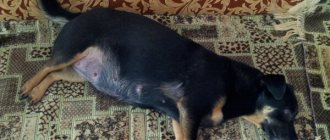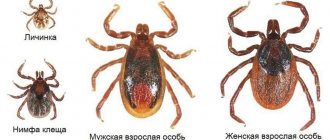No matter how much we would like it, not all births occur without complications. Even if the first few births for a bitch went without difficulties, complications may arise during subsequent ones. Birth pathologies can be of a different nature: some may be associated with the individual characteristics of the dog’s physiological structure, while others may be associated with the unacceptable position of the puppies in the uterus, their death, etc.
All pathologies of Spitz birth can be divided into 2 types:
- those that arise from a cause dependent on the mother dog, and
- those that occur for a reason dependent on the puppy.
Pathologies can also be divided according to the principle of assistance provided:
- those complications that the dog owner himself can help with;
- those complications that require the intervention of a veterinarian exclusively (complications that are more dangerous to health and life).
It is impossible to predict how events will develop: during the course of labor, various emergency situations may arise, some not very scary, and some requiring qualified assistance from a veterinarian.
That is why, in order not to tempt fate, it is advisable to have a doctor present during childbirth , especially if the dog is whelping for the first time, if it is out of condition (overfed, excessively skinny) or “aged.” The best thing is to invite a specialist to your home: here the dog will feel comfortable and confident, and will not experience unnecessary stress, but you can (of course, in advance) assign the Pomeranian to the veterinary hospital.
If you did not invite a veterinarian to the birth, and complications arose during whelping, be sure to call a doctor at home as soon as possible! Since transporting a giving birth dog to a veterinary hospital is an extremely dangerous event for the life of the dog itself and for its offspring.
When it is not possible to call a veterinarian
It is possible that there are situations when there is absolutely no way to call a veterinarian at home. In this case, the dog owner may be required to provide medical care that he would not otherwise be responsible for. But it is worth paying due attention to the fact that whatever the prevailing circumstances, the dog breeder should not use any tools
. Medical instruments in the hands of an inexperienced person can turn into the worst enemy for a giving birth dog and its offspring! It would be very helpful if you had a list of veterinary first aid telephone numbers and a veterinarian’s telephone number on hand - they will be able to advise you in this situation.
Poor circulation in a pregnant dog
In the case of multiple pregnancy, the dog may experience a complete loss of strength, or so-called collapse, already a week before giving birth. In this condition, the dog is inactive and spends most of its time lying down with its hind legs extended back, breathing heavily. This happens because the huge uterus compresses not only neighboring internal organs (liver, spleen, lungs), but also large blood vessels, as a result of which the dog’s blood pressure drops and the blood supply to the internal organs is disrupted.
If your dog's behavior matches the description of the symptoms of this complication, do not waste time, call your veterinarian. If there are no more than 7 days left before the expected whelping date, a cesarean section is the best thing that can be done in this situation.
Here are some of the most common complications
which occur in Spitz dogs
during childbirth
.
Causes of abdominal muscle diastasis
The main reason for the discrepancy is the excessively high pressure that occurs in the abdominal cavity. At the same time, the prerequisites for increased intra-abdominal fluid are of different nature. These include:
- Loss of muscle elasticity as a result of rapid weight loss.
- Excessive physical activity.
- Dysplasia is the abnormal development of tissues and organs. In addition to diastasis, it is accompanied by many additional manifestations: hernia, varicose veins, hemorrhoids, etc.
- Pregnancy. As a result of hormonal changes, collagen production is reduced, tissues lose elasticity and become loose. At the same time, the enlarged uterus significantly increases pressure on weakened muscle structures and the linea alba.
In 60% of cases, diastasis in women is associated with pregnancy. Pathology begins to develop in the middle of the second trimester. It is at this time that the muscles are stretched under the influence of increasing abdominal pressure. Normally, after childbirth, the uterus restores its previous size, and the width of the white line returns to its normal value of up to 2 cm.
However, in many cases, the recovery process is complicated by concomitant factors that prevent the tissues from returning to their previous position. These factors include:
- mature age of the woman in labor;
- excess weight before and during pregnancy;
- the fruit is too large;
- number of previous pregnancies and births;
- type of pregnancy (one fetus or several);
- complications during pregnancy;
- too rapid return to active physical activity after childbirth.
Diastasis can also occur in children, especially premature babies. The key prerequisite for the development of pathology is the failure of the child’s muscles and tendons. In this case, most often the defect is eliminated on its own during the first year of the baby’s life. During this period of time, the muscles acquire tone, the ligaments become strong. Only children with Down syndrome are at risk of maintaining the discrepancy.
In only 1.5% of cases, diastasis is diagnosed in men. The basic prerequisites are the same as for women: obesity, dysplasia, sudden weight loss. Also, men are more likely to be overly involved in strength training, which not only causes hernias and varicose veins, but also provokes the formation of diastasis.
Large puppy, puppy without signs of life, incorrect presentation of the puppy
If 2-3 hours have passed since the start of contractions, the bitch makes intense attempts, but the puppy does not show up, the reason for this may be the reasons listed above.
In such a situation, you need to understand that one delayed puppy can cause the death of the remaining puppies in the bitch’s uterus. Most often it happens that after a difficult birth of the first puppy, the rest are born without difficulties, provided that the bitch was given help and she did not waste her strength on fruitless attempts to push the puppy out.
If during delivery you notice signs that at least somehow indicate that the puppy is delayed, call a doctor immediately.
Since the signs in all these cases are quite similar, only a specialist can understand what exactly happened. After finding the cause of the complication, the doctor will first make the necessary injection and watch: if the puppy does not appear after the assistance provided, he will decide on the need for a cesarean section. And the faster the bitch receives help, the greater the chance that subsequent puppies will survive.
It is very important to provide first aid in a timely manner, because a retained fetus, if it is already dead within 24 hours, is a huge source of infection that threatens the health of the bitch. The more time it spends in the dog’s body, the more its condition will worsen, which will lead to the fact that the bitch will not be able to feed her cubs in the best case, or will die in the worst case.
If contractions and pushing continue for 2 hours, you need to check whether the puppy has reached the exit into the bitch’s pelvis and whether he is moving further along the birth canal
.
You can tell if the baby is in the pelvis by feeling the dog’s belly. To do this, place your hand under her belly with your thumb on one side of her belly and the rest on the other. Try to carefully feel the puppy through the dog’s skin and thereby determine its location. You also need to feel the dog’s perineum with your free hand: do you feel something hard under it, and also understand whether the puppy’s head has passed through the pelvic opening.
Next, you should make sure that the baby does not move along the birth canal towards the vagina. You need to cut and file your nails, wash your hands very well and treat them with an antiseptic such as synthomycin emulsion, for example. Then gently insert your finger (little finger) into the bitch's loop until you feel the puppy. Take a break for 20 minutes and repeat the procedure. Draw a conclusion about whether the position of the fetus has changed or not. If the puppy remains in the same place, immediately call a veterinarian or, if this is impossible, immediately call an emergency veterinarian.
Large puppy
If the puppy is quite large
Regarding the size of the birth canal, during childbirth problems arise with the movement of such a puppy along the birth canal.
There are complications associated with the large size of the puppy, in which the puppy may only appear slightly out of the loop and no longer move out. In such cases, you can help the dog with your hand
. You should first take all precautions: cut your nails and file them, wash your hands thoroughly and lubricate them with an antiseptic (pre-prepared syntomycin emulsion). Then proceed directly to help: insert your finger into the dog's loop so that you can hook the puppy. During the beginning of the wave, push as gently as possible, but at the same time strongly pull the puppy in an arc: towards you and down.
Dead puppy
If during pushing the puppy begins to show itself, and you are absolutely sure that he is not showing signs of life
, during the next series of pushing you need to try to pull the puppy out. This is important so that the remaining puppies are born alive and do not suffocate in the birth canal, being detained dead.
Malposition
During whelping, only two presentations of the fetus are considered normal - cephalic and pelvic. With a cephalic presentation, the puppy passes through the birth canal head first, and with a breech presentation, accordingly, with the pelvis.
One of the abnormal presentations of a puppy is cervical presentation. This means that the puppy's head is turned inward, and he approaches the pelvic opening of the bitch with his neck. This position of the puppy prevents its smooth exit from the vagina.
The sooner the veterinarian understands the reason for the delay in labor, the greater the chance of saving the dog and its puppies.
Stuck Puppy
Complications during whelping can occur even if the puppy is presented correctly. One such complication is a stuck puppy. It may happen that during childbirth, the puppy emerges halfway from the bitch’s vagina... and stops, as if stuck: the bitch has a spasm of the vaginal muscles, and they have captured the puppy in a death grip.
In this situation, you cannot pull the puppy! This way you can damage it. You need to give the bitch an injection of an antispasmodic agent: 0.5 ml of no-shpa into the tubercle located just above the dog’s loop, or 1 ml intramuscularly. A few minutes after the injection, the spasm will disappear and the muscles will relax. If the puppy does not begin to move forward in the next series of pushes, you will need to assist the laboring dog. To do this, cut off the legs (if you have not done this before), wash your hands, treat them with syntomycin emulsion and try to insert your finger as carefully as possible either under the puppy or to the side of it. Try to help him get out by slightly pulling the puppy in an arc downward. Do not pull the puppy under any circumstances!
How to determine the presence of abdominal muscle diastasis yourself
Diastasis can be determined at home. A simple test will help you do this, during which you need to measure the distance between the edges of the rectus muscle.
To do this, you need to lie on your back on a hard surface, bend your knees. Place one hand under your head and the other on the white line, just above your navel. Then you should relax and raise your chest. In this case, you need to feel the discrepancy between the muscles with your fingertips. The gap is most pronounced between the navel and the xiphoid process. If the discrepancy is greater than the width of two fingers, this should alert you and be a reason to contact a specialist.
This technique is as similar as possible to the approach that a surgeon uses for diagnosis. This is the easiest way to determine diastasis at home without the help of a doctor and instrumental examinations.
Narrow pelvis
The narrowness of the dog's birth canal can also cause complications. The cause of a narrow pelvis is either a deviation in the anatomical structure of the dog’s skeleton, or rickets or pelvic injuries suffered in childhood. Although rickets is extremely rare, since there are a huge number of special medications designed to protect the puppy from this disease, it is worth keeping in mind that this deviation does occur.
If you have reason to think that your dog may have a narrow birth canal, conduct appropriate research, and if the diagnosis is confirmed, the right decision would be to refuse mating altogether.
If a dog gives birth with a similar pathology, during the process of the bitch’s attempts, the puppies’ membranes appear for a while from the loop and disappear as soon as the series of attempts is completed. If the dog fails to give birth, she must have a caesarean section. Ineffective attempts and contractions not only tire the dog, but also have an extremely negative effect on the muscles of the birth canal: they become tired and swell, which can lead to rupture and prolapse of the vagina. Don’t tempt fate: at the slightest suspicion of this pathology, call a doctor, his help is necessary!
Signs of abdominal muscle diastasis
For a long time, the pathology has an asymptomatic course. Manifestations increase as the discrepancy develops and complications appear. And if in women the signs of diastasis of the rectus abdominis muscles are maximally manifested after pregnancy and childbirth, then in men - only when the pathology is already in an advanced state.
The main and most noticeable manifestation of the pathology is a rounded vertical protrusion of the abdomen. If you deliberately tense your abdominal muscles, a groove between the right and left halves of the body becomes visible. At the same time, in men, even with intense strength training, the abs are not sufficiently worked out and do not acquire the desired relief.
If the disease progresses, the pathological structure of muscle tissue and disturbances in muscle function become the cause of other, more dangerous characteristic manifestations. There are:
- pain in the spine, lower back;
- posture disorders;
- increased fatigue;
- dysfunction of the gastrointestinal tract, which is accompanied by heartburn, belching, pain, constipation, flatulence.
At the third stage of the pathology, dangerous complications are possible, which manifest themselves in the form of:
- ptosis, prolapse of internal organs;
- intestinal obstruction;
- urinary incontinence;
- renal colic;
- feeling of heaviness in the legs while walking;
- muscle atrophy in the abdominal area.
Weak labor of the dog/absence of labor
This means that after long and fruitless efforts, the uterus becomes exhausted, contractions and accompanying efforts can either become very weak or stop altogether. This can occur both from the very beginning of labor and after the birth of several puppies.
There are dozens of reasons for this problem: poor condition, old age, lack of physical activity, various past illnesses, lack of vitamins, hernia and others. If you know that your dog has a hernia and you are planning to breed the dog, make sure to remove the hernia no later than six months before the planned breeding. Another reason for weakened labor may be a disorder in the hormonal balance of the bitch, which can be attributed to poor heredity. Dogs with these abnormalities experience more frequent disturbances in the estrus cycle compared to other dogs.
If you notice that the dog has no contractions or attempts (or they are very weak) for 12 hours, it is necessary to enhance labor artificially without the use of various stimulants.
Giving a dog such hormonal stimulants, such as oxytocin, would be a big mistake on the part of the dog owner. Injecting the drug before the cervix is fully dilated or taking an excessive amount of it (read overdose) can lead to serious, even fatal, consequences for both the dog and the puppies. Hormonal stimulants are extremely powerful drugs that can cause uterine wall rupture or uterine inversion.
Only a veterinarian can decide whether it is necessary to use it
after determining that the bitch’s birth canal is fully dilated, that is, the cervix is well dilated, that the bitch’s pelvis is not narrow, that the fetus is of normal size and located without abnormalities, the dog itself looks and feels normal. Before giving an injection of a hormonal stimulant, the veterinarian decides on the need to administer a solution of calcium salts to stimulate contractions. After about 10-20 minutes, contractions will begin, and the puppies will appear quite quickly and easily.
If the use of a hormonal stimulant does not have an effect, the veterinarian will perform a caesarean section.
Sometimes, based on the results of examining the bitch, the doctor immediately decides on the need for a caesarean section without using a stimulator simply because it will not help in this situation: for example, if the size of the puppy does not correspond to the size of the pelvic opening.
Sometimes such complex and difficult births occur that a dose of a stimulant is necessary for the birth of each puppy. In such a situation, contractions become very strong, the uterus quickly becomes exhausted and stops responding to such injections.
So, you've changed your mind about giving your bitch a stimulant injection, but you can still help your beloved dog.
To stimulate labor before the birth of the first puppy, give your dog injections of the following medications:
- 2-3 ml of ascorbic acid intramuscularly;
- 5% glucose solution subcutaneously or intravenously (that is, using a dropper) at the rate of 5-10 ml per kilogram of the dog’s weight;
- 10% solution of calcium gluconate intramuscularly at the rate of 0.5 ml per 1 kg of animal weight. The temperature of the infused liquids should be about 40 degrees Celsius.
Don't forget to wash your hands thoroughly first; use exclusively disposable syringes, as well as alcohol to disinfect the injection site. When medical assistance has been provided, begin a special massage of the dog in order to enhance labor.
.
So, massage to intensify contractions
:
- Using light hand movements, massage belly
from head to tail. If you feel a wave of pushing along the dog’s stomach and sides, follow it with your hand, as if intensifying it. - After lubricating your hands with baby cream/vaseline/baby oil, use your index finger and thumb to massage the base of
your dog's tail, as well as the area
between the dog's butt and his anus
. - Massaging
the dog's nipples, as well as expressing a small amount of milk, helps stimulate labor - Internal vaginal massage
. To do this, you need to wash your hands thoroughly, trim your nails and file them well so as not to scratch the delicate mucous membrane, and lubricate the finger involved in the massage with synthomycin emulsion. Do not insert more than one finger into the vagina of dwarf dogs, in particular Pomeranians! To perform a massage, insert your little finger into the vagina in a forward-upward direction and massage its walls, performing circular movements with your finger. With your other hand (or with the help of your assistant), simultaneously massage the dog's stomach in the direction from the ribs to the groin in rhythm with the pushing. At the moment when contractions appear, remove your finger from the vagina. If contractions do not appear within 3 minutes, stop stimulation and repeat it after 15-20 minutes.
If, after carrying out all the described measures, as well as in the absence of results from drug therapy, the bitch cannot give birth, you need to immediately seek help from a veterinarian! Most likely, a caesarean section will not be possible.
Important!
In addition to the fact that procedures for inserting a finger into a bitch’s vagina are extremely unpleasant for a dog, they are quite dangerous, since there is still a chance of introducing microbes to the bitch’s mucous membrane. Therefore, this measure should only be resorted to in the most exceptional circumstances.
It also happens that contractions weaken after the birth of one or more puppies.
Help in this situation is identical to that suggested for inducing labor before the birth of the first puppy, except that at this stage (that is, after the birth of one or more puppies), you can give the dog 1 ml of oxytocin IM if your vet approves! Usually, after injection of the stimulant, the dog’s labor activity improves, as a result of which a puppy is born after 5-10 minutes. The administration of oxytocin can be repeated no earlier than 2 hours after the birth of the puppy and provided that the dog gives birth after the injection.
But, despite the use of a stimulant, the bitch is not always able to give birth without the intervention of a specialist. Therefore, if the simulator did not help the dog (she did not give birth), call the veterinarian immediately, because the bitch needs to have a caesarean section, and the sooner the better for everyone!
How does a doctor determine the presence of diastasis of the rectus abdominis muscle?
If any of the listed symptoms appear, as well as if there are predisposing factors such as recent pregnancy and childbirth or increased physical activity, you should consult a doctor for examination. You can’t delay your visit; it’s better to see a specialist for prevention than to wait until dangerous complications appear.
Many people do not know which doctor determines the presence of diastasis of the rectus abdominis muscles. You need to contact a surgeon. In most cases, an experienced specialist will be able to determine the pathology using only palpation examination.
For diagnosis, the patient lies on his back, slightly bends his knees and rests his feet on the surface. After this, the surgeon asks you to tighten your abdominal muscles. At the same time, you need to raise your shoulder blades and head. The doctor feels the abdomen, measures the width of the discrepancy, and determines the presence and stage of the pathology. In this case, pronounced diastasis of the third degree is noticeable even in a standing position.
In some cases, the study of the width of the white line is complicated by excess body weight. The doctor refers such patients for an ultrasound examination. This procedure is also prescribed if there is a suspicion of the development of complications: hernial protrusions, displacement of internal organs. In rare cases, radiography or computed tomography is necessary.
Absence of labor
If you notice that after the bitch’s water breaks, contractions do not appear for some time, that is, labor is completely absent, seek help as soon as possible (no later than 2 or, at most, 3 hours) to the vet! Do not leave the dog alone at this point because there is a very high possibility of death of the dog and puppies.
The reason for the absence of contractions and pushing may be adhesions formed after a previous cesarean section.
End of the first stage of labor
Position. If labor continues and the intensity of contractions increases, then the woman should take a position that is comfortable for childbirth. It needs to be constantly supported. The woman in labor should remain relaxed both between and during contractions. But even if she skillfully relaxes and feels well, she still should not be left alone, moreover, she should be aware of the presence of her husband or other assistants. There is no need to bother the woman in labor with unnecessary vaginal examinations or other “intrusions.” The baby's heartbeat can be monitored from time to time without distracting the mother or forcing her to change position.
It is important that the mother's bladder is empty and that she uses the bathroom frequently during the early stages of labor. Now she should lie down in bed and completely relax - all joints should be free and slightly bent. If she is lying on her side, then place a large, dense pillow under her knees and hips. The woman in labor must conscientiously get rid of all muscle tension - hips, lower abdomen, back, pelvis.
Relaxing during the first stage of labor can have a huge effect. If the patient is well trained and trained, then she should not have any difficulties in anything. During the normal course of the first stage of labor there is usually no pain, only during the last stage some discomfort sometimes appears.
The calmer the woman in labor, the more relaxed she is. The doctor should remember that he should not be ambitious and expect too much from the patient.
Inelastic soft tissue of the vagina (birth canal)
This problem is not a pathology, but a distinctive feature of childbirth in dogs that are whelping for the first time. As soon as the bitch gives birth to her first puppy, this problem disappears. And in order to ensure a problem-free birth for the first puppy, you need, as with a dry birth, to use Vaseline oil, which has been previously sterilized in a pan with water for 2 hours and cooled to room temperature. Lubricate the inside walls of your dog's vagina, then try to gently stretch the vaginal tissue, making it more elastic. Your hands should also be sterile (washed with soap and treated with alcohol), your nails should be cut short and filed.
If after this procedure the bitch cannot give birth to a puppy, carefully tear the amniotic sac of the puppy and slowly pull the puppy towards you in time with the attempts made by the bitch. Such childbirth is quite painful for the dog - it may squeal. But the pain ends with the birth of the first puppy, the rest of the babies are born easily and quickly.
The doctor present at the birth can make an incision on one of the dog's labia to help the new puppy and bitch being born. And since an open wound can become infected, you should try to avoid surgical intervention during childbirth.
How many puppies are born to Yorkies?
The Yorkshire Terrier is one of the most popular breeds of small decorative dogs for home keeping. It was developed only at the end of the 19th century, but nevertheless became widespread almost throughout the world. It appeared here in the 70s of the last century.
The popularity of the dog is probably due to its good-natured and cheerful character, its modest size, which allows you to take it with you on any trip, as well as the extremely low hassle associated with caring for it.
If you have or are just about to get this cute creature, you may be wondering how many puppies are born to Yorkies and how the birth process proceeds. You will receive answers to these questions below.
How many puppies do Yorkies give birth to?
The process of childbirth in Yorkies proceeds quite quickly. Each puppy comes out approximately 30 minutes after the previous one. This time is necessary for the woman in labor to process the offspring - to remove the membrane, bite the umbilical cord and lick it. You can help her with this, especially if this is her first birth.
And yet, how many puppies are born to Mini Yorkies? It’s difficult to call them fertile. Usually only a couple of puppies are born at a time. Sometimes their number is 4-5.
Retained placenta (placenta with membranes)
The practice of dog breeding shows that it is often the release of the placenta that is delayed after the birth of the last puppy.
Within 2-5 hours after birth, the placenta may come out on its own. It is very important not to miss this moment! Do not leave the bitch alone, but while on a walk, carefully look to see if the placenta has passed, since it is very similar to dog excrement.
If the placenta does not pass away on its own within the specified time, it is necessary to provide the bitch with first aid.
. Give the dog an injection of 1 ml of oxytocin, then place it on its hind legs in the bath, start pouring warm water from the shower over the Spitz's belly, combining this with a belly massage with gentle movements from top to bottom.
Usually this procedure is quite sufficient to solve the problem of placenta retention.
The placenta remaining in the birth canal can lead to purulent inflammatory processes in the uterus ( metritis ), and this is deadly!
If you have even the slightest doubt that the placenta has not passed away, you need to show the dog to a specialist. Qualified help consists of giving the bitch a special hormonal drug that causes contractions of the uterus, as a result of which the placenta soon comes out. Plus, the veterinarian will inject an antibiotic that prevents the development of infection.
Abnormal articulation and fetal position in dogs
Turning the head to the side. Only underdeveloped puppies can be removed without correcting the position of the head. Correcting the position of the head using a hook inserted into the eye socket or ear canal, or a forceps, is possible only in large bitches. In small breed dogs, caesarean section is indicated.
Lowering the fetal head down. In this case, you can try to remove the head by pressing on the skull with a finger inserted into the vagina, while simultaneously pressing with the other hand on the abdominal wall. If the fetus is small, then you can bring the head into the birth canal with a hook attached to the bend of the neck without first straightening the head. If the result is negative, a caesarean section is resorted to.
Throwing back of the fetal head. This malposition of the fetal head is rare in bitches. In this case, the hook is inserted into the chest and abdominal cavities of the fetus and the walls are torn with it. This reduces the volume of the body, as the internal organs fall out. Then the hook is placed behind the bend of the neck and the fruit is removed. In bitches of small and dwarf breeds, without wasting time, they proceed to a caesarean section.
Flexion of the joints of the thoracic limbs. In puppies, flexion of the elbow and shoulder joints is considered a physiological phenomenon, since during normal labor the fetuses are expelled from the uterus. When bending the limbs at the wrist joints, blunt hooks are used or the limbs are pushed as far into the uterus as possible, after which forceps are applied to the head and the puppy is removed out.
Flexion of the joints of the pelvic limbs. If the limbs are bent at the hock joints, you can use blunt hooks that are placed above these joints. In females of large and medium breeds, this malposition of the limbs can usually be easily corrected. In bitches of dwarf breeds, the fetus is removed using forceps placed on the fetal pelvis, without first correcting the limbs bent at the hock joints.
When the limbs are flexed at the hip joints, the fetus can be removed without correction using hooks.
The position of the fetus is considered correct when the longitudinal axes of the fetus and the birth canal coincide. But sometimes variants of incorrect position are observed.
Transverse position with abdominal presentation. In this case, the fetus lies transversely, and all four limbs are directed into the birth canal. The fruits of bitches rarely take the classic transverse position. Presentation is often thoracic when the head is positioned in the other horn. In large breed bitches, the front part of the fetal body should be straightened and then the fetus should be removed. In bitches of medium and small breeds, the fetus can only be extracted by caesarean section.
Transverse position with dorsal presentation. In this case, the fetus lies with its back to the exit of the birth canal. With a finger inserted into the birth canal, you can feel the spinous processes of the fetal spine. In such cases, it is usually possible to extract the fetus only by performing a caesarean section.
Simultaneous entry of two fetuses into the birth canal. During normal whelping, the fetuses are expelled from the uterus sequentially (one after the other). But sometimes two fetuses become wedged into the birth canal. With this anomaly, four pelvic limbs, two pelvic and two thoracic, a head and two pelvic limbs may be shown. By palpation through the abdominal walls, one can detect the entry of two fetuses into the birth canal.
Sometimes, before entering the pelvis, adhesion (collision) of the fruits may occur. This happens when the fetuses enter almost simultaneously, with the first of them being in the breech presentation, and the second in the cephalic presentation. Providing assistance with the simultaneous entry of two fetuses into the birth canal consists of applying a forceps or bullet forceps to the presenting parts of one fetus and pushing away the other fetus with a finger inserted into the vagina. With the other hand, it is simultaneously necessary to help push the fetus through the abdominal walls towards the mother’s chest.
When clutching fetuses, it is necessary to pull back the fetus coming from behind and at the same time push away the fetus that has partially emerged from the birth canal. After separation of the fruits, the first one is removed, and the second one usually comes out without assistance.
Choke puppy, reviving weak puppies
In the case of complex and lengthy labor, in which the puppies remain in the mother’s birth canal longer than normal, a complication such as a “choked puppy” occurs. When born, such puppies appear dead: they do not move, do not squeak, have a thin and flat elongated body, often due to lack of oxygen they are bluish in color, especially the face and paws. But it is only at first glance that they seem unviable: if such a puppy is immediately given first aid, he can be revived. So there is no need to write off the puppy without trying to revive it for at least 10 minutes. Puppies that were born by caesarean section should also receive artificial respiration and a warming massage using heat. The fact is that they may have breathing problems due to the anesthetic that entered their body through the blood from the mother.
Resuscitation of a choking puppy
To start the process of pulmonary breathing in a weak puppy, you need to carry out a number of procedures:
1. Clearing the respiratory tract of mucus or liquid present in them.
To do this, first wipe the puppy’s nose and mouth with clean gauze or cotton cloth, then securely fix the newborn with your hands (one for the neck and head, the other for the spine), lift it and shake it several times from top to bottom. The shaking movements can be compared to the movements made when chopping wood. Just be careful: the puppy may slip out of your hands - wipe it with a dry cloth or gauze.
It is advisable to perform this procedure on all born puppies without exception.
Then take the puppy by the tail upside down and, wrapping your lips around the puppy’s mouth and nose through a thin sterile diaper or gauze, suck out the liquid from the puppy’s mouth and nostrils and spit. Hold your puppy in this position for a few more seconds, then lower him and begin to follow these steps to revive him.
2. Rub the scruff of the neck vigorously
newborn baby against hair growth.
3. Pull out the puppy’s tongue and place 1 or 2 drops of valerian or cognac on the back of it.
4. Ammonia can make the puppy take a breath: let the puppy sniff a drop of ammonia
on a piece of cotton wool.
5. If you manage to get the puppy to start breathing, but his breathing is uneven, you should resort to artificial respiration
. To do this, take the puppy with both hands so that it is located across your palms (the head should be in your right hand, and the tail in your left) and as if hanging with its paws down, begin to bend and unbend the puppy in the direction of head to tail. Perform these movements ~20 times per minute. This procedure will normalize the breathing rhythm.
Also, to stimulate breathing and the work of the heart muscle, squeezing the chest will help: place the puppy with its back down, for example, on your lap, and begin to lightly press on the puppy’s chest according to the pattern of 1 pressure per 1 second, accompanying artificial respiration by flexing and extending all the baby’s legs.
6. rubbing
of the puppy, wrapped in a hot, dry towel,
has worked well to revive puppies .
7. To stimulate breathing, follow this procedure: take the puppy in your hands and alternately turn it head down, then tail. During this procedure, the newborn’s lungs will either be compressed under the weight of the abdominal organs, or expand. Repeat these movements for approximately one minute at a rate of one inversion every three seconds.
8. If all of the above measures do not have the desired effect, you should resort to contrast baths
. Prepare two containers with cold and hot water and begin to alternately place the puppy in one container, then in the other so that the head remains above the surface of the water. Repeat several times.
If the puppy does not show signs of life after all resuscitation procedures, repeat everything from the beginning. Don't stop trying until your puppy takes a good deep breath. But if within 15 minutes the newborn has not “come to his senses,” alas, you will no longer revive him. Also, you are unlikely to be able to revive a weak puppy with a white tongue, but it’s still worth a try.
All procedures to revive the puppy and stimulate pulmonary respiration should be carried out in a sufficiently warm place .
It often happens that it is the first puppy that ends up choking, and after its birth, subsequent puppies are born without problems and quite quickly. In this case, it may be more appropriate to sacrifice the first puppy in order to help the stronger living puppies.
Lively puppies remain weak at first and may find it difficult to suckle, so give them special attention and help until they gain strength.
What is diastasis
To understand this concept, it is necessary to briefly outline the structural features of the abdominal muscles. In the center of the abdomen is the rectus muscle. It begins in the lower abdomen and extends to the pubic bone. Consists of two sections that are connected in the center by loose fabric. This connective tissue is called the linea alba.
As a result of prolonged and strong tension of muscle structures, intra-abdominal pressure increases. Weak tissues of the white line cannot withstand the load and begin to diverge. At the same time, the distance between the sections of the rectus muscle increases, they diverge to the sides and move several centimeters away from each other. A kind of furrow is formed, and when tense, the stomach protrudes unnaturally. Pathological discrepancy can form under the navel, above it, or have a mixed form.
The pathology should not be confused with a hernia of the white line or with an umbilical protrusion. It does not threaten to infringe on internal organs. But at the same time, even at an early stage it represents an aesthetic problem, since diastasis of the rectus abdominis muscle is much more often determined in women than in men.
Depending on the degree of discrepancy and the size of the formed distance, diastasis is divided into three degrees:
- first - the distance between sections is from 2.5 to 5 cm;
- second - the discrepancy reaches a gap of 5-8 cm;
- third - the size of the furrow between the sections exceeds 8 cm.
This classification allows you to understand how to determine the degree of muscle diastasis even at home.
Pathology can also affect other muscle structures of the anterior abdominal wall. Depending on what surrounding tissues are involved in the process, four types of diastasis are distinguished:
- A - classic form, in which only the rectus muscle diverges;
- B - loss of tone in the inferolateral muscle sections;
- C - appearance of expansion in the area of the xiphoid process, ribs;
- D - curvature of the waist line.
Service
Summary: when a doctor is needed
Let's summarize and, in the form of abstracts, note those moments in which the presence of a doctor is strictly necessary, because it will help save the life of a giving birth dog and its offspring:
- ineffective long-term (more than two hours) contractions and attempts. Be sensible and don't let your dog suffer for such a long period of time;
- weak labor activity/absence of labor activity;
- large puppy, malpresentation of the fetus, infertility;
- prolonged gestation of puppies, that is, the absence of labor later than the scheduled due date (pregnancy more than 65-67 days);
- the presence of bloody, brown or green-tinged vaginal discharge during pregnancy or the onset of labor;
- not all the placenta passed away/puppies died during childbirth, while the dog’s body temperature exceeds 39.5 degrees Celsius;
- you are not sure that the dog gave birth to all the puppies;
- heavy breathing, a blank look, convulsions, copious bright scarlet discharge during childbirth, or abruptly stopped attempts - evidence of a rupture of the vagina or uterus - call a doctor immediately!
- Increasing weakness, pallor of the mucous membranes (tongue and gums), loss of consciousness may indicate severe internal bleeding
-
call the clinic immediately!
Preparing for childbirth
Experienced breeders have completely different views on where and how a dog gives birth: some are sure that a pet should whelp exclusively on a bed, sofa, or at least on soft bedding. Others immediately put it in a spacious box in which the mother and her children will spend the near future.
What you will need
Be sure to prepare a first aid kit for the mother in labor or babies. It should contain the following:
- iodine and brilliant green;
- antiseptics (medicinal alcohol or peroxide) - they will come in handy when you need to treat instruments or hands;
- in case the bitch does not gnaw the umbilical cord herself, it is better to get special scissors;
- clamp;
- syringes;
- cotton wool, bandages, gauze and other dressing materials;
- suction in case puppies are born in a bubble and cannot breathe normally;
- Oxytocin injections are helpful if your dog is not having contractions.
Clean cloths and disposable diapers never hurt. It is worth stocking up on water so that the bitch can quench her thirst during childbirth.
It would be ideal if one of the family members takes a short vacation during the whelping period and takes care of the mother and her babies. This can be called a necessity if the dog is giving birth for the first time.
Where to place the dog
Of course, a bitch will give birth in any conditions, but decent owners still take time to arrange a comfortable and convenient nest. The bed is not the best place for dogs and puppies, as the animal will not find it very secluded. Rapidly grown puppies will begin to crawl and fall, which will lead to serious injuries to fragile babies. In addition, discharge during childbirth can stain everything, including the mattress - so this option is not the most hygienic.
Almost all owners prefer to place their pet in a box covered with soft material. The puppies will not have the opportunity to get out, which means they will remain under the strict supervision of their mother. Another plus is that during the birth process the dog has the opportunity to rest its hind legs on one of the sides, and this will greatly facilitate contractions.
There are several rules that need to be followed when arranging a family house for a dog.
- Choose a box based on the size of your dog. A box that is too tight is just as bad as one that is too spacious. The bitch should fit in it herself, and also leave room for the puppies.
- The sides of the box must be no lower than the height of the animal in a lying position.
- Cover the bottom with a light cloth. Thanks to this, you can control discharge before, during and after childbirth. Do not forget to promptly change the soiled diaper to a dry one.
- It is best to place a mattress or a sheet of thick foam rubber under the diaper. This will allow the mother to sit comfortably inside and reduce her discomfort.
- Prepare a second, smaller box. Puppies must be placed there before giving them to their mother. Place something warm inside the box - a heating pad wrapped in cloth.
Be sure to let your dog get to know your box beforehand. Let her get used to it. If this is not done, the animal will find its own secluded place, to which a person will most likely have difficulty accessing. And the presence of the owner is mandatory during dog births at all times.
Place the box in a visible place and put some treats in it. If your pet does not get into it for a long time, pay attention to whether you have chosen the right size and bedding.











